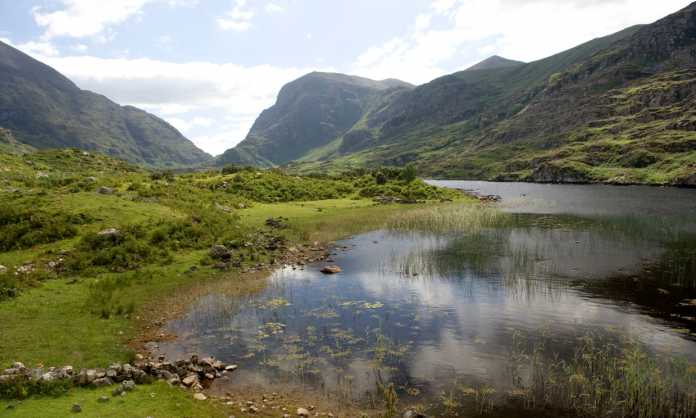By Pádraic Ó Duibheannaigh
One of the places our parents used warn us about when we were young was the turlough in our neighbour’s pasture field. That was because the drain that bordered it ended in a swallow-hole, or ‘swalley hole’ as we called it.
Furthermore, we could only approach this place by taking a path from our farm that skirted dangerous bog-holes. Naturally, being off limits the turlough had the allure of the forbidden, so as we grew older we visited it whenever the opportunity arose.
What made the turlough fascinating was that it only appeared after heavy rainfalls. It would be there for weeks in winter but in summer, when the pastureland it flooded was green, the overnight appearance of this lake was magical. Part of its attraction was that, visits to the seaside being extremely rare and the nearest lake dangerous for non-swimmers, it afforded local boys the opportunity to bathe.
As the turlough was shallow, except where it covered the drain, it warmed up quickly. We stripped off and splashed in till the water was knee-high then threw ourselves forward. The feel of soft grass under our hands and feet was reassuring and we could turn on our backs and attempt to float.
Of course there was always the fear that if one of us got too close to the swallow-hole he would be sucked down into some bottomless chasm. What we didn’t realise was that the drain, which was really a small river, sank under the hill at this point only to re-emerge on the far side about three-quarters of a mile away before flowing into the nearby, reed-encircled lake.
Since we boys were stark naked when bathing, no girl would ever think of approaching. I don’t want to give the impression that there were many of us; usually there was just me and my brother and two athletic sons of a neighbouring farmer who had learned to swim in the lake – I can still remember one of those tearaways jumping naked on the back of a horse grazing in the field and riding him, whooping like a Red Indian, into the turlough, sending up a glittering shower of spray.
As we grew older the turlough offered other attractions. Moorhens might be glimpsed near the drain, while in the cutaway bog on the north side curlews and snipe nested. The musical calling of curlews was one of the reminders that spring had returned and the drumming of the cock snipe, the minawn aerach or airy kid, in the evenings was haunting.
Then in late autumn ducks and swans arrived to feed on the lush grass under the water. Occasionally as we approached across the bog the wild notes of whooper swans could be heard. After one stormy night when the plaintive clamour of these migrants was carried on the wind to my bedroom I visited the turlough and found a swan that had flown into overhead electrical wires. Had the flock been lamenting the death of one of its members?
When my brother and I got older and were allowed to use our father’s single-barrelled shotgun, the turlough was a great place for shooting wildfowl by night. How different the place looked then, its familiar features erased by darkness so that it took on a menacing, primordial aspect. How we welcomed the moon when it rose, huge and splendid, over the eastern hills to throw a glowing causeway across the water. One could understand why primitive man regarded this celestial orb as a goddess.
The faint musical beat of wings warned of the approach of mallard, teal or widgeon and then as they crossed the face of the moon we fired. A splash told if our aim was accurate and we retrieved the fallen bird. Later I learned that shooting wildfowl by moonlight is illegal but at that time I just regarded it as great sport. It’s been years now since I have visited the turlough. Nevertheless, when it rains I like to picture it there, glowing invitingly among its green fields.








